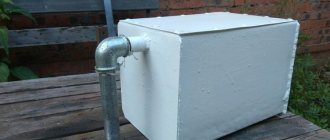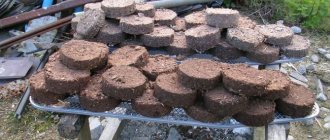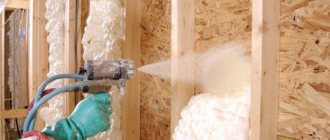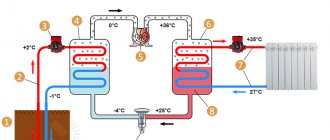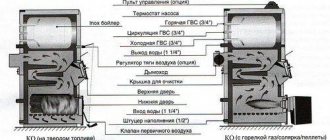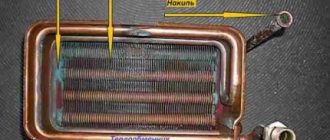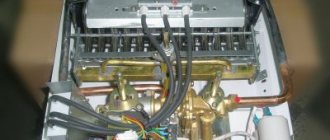Steam generators are widely used for arranging baths, steam rooms, cleaning all kinds of equipment and in the production of alcoholic beverages. Such units allow you to effectively warm frozen pipes and car engines in winter. A homemade unit will function no worse than a purchased analogue if it is properly made at home. Together with the editors of Seti.guru, in today’s review we will look at how to make a steam generator with your own hands for various household needs, and we will also analyze in detail the features of installation, assembly and testing the operation of the unit.
Homemade solid fuel steam generator
Types of steam generators and their use in the household
Regardless of the purpose, the design of steam generators contains a reservoir - a boiler, in which steam is generated and supplied to an external consumer. Based on the type of supply of working fluid (water), it is customary to distinguish between manual types of units and automatic units. Depending on the amount of power consumed, steam generators can be industrial or domestic. For household units, this figure, as a rule, does not exceed 9 kW, and they are connected to a 220 V power supply (industrial units - to 380 V).
Industrial steam generating plant
Depending on the method of heating the working fluid (water), steam generators can be induction, with electrode installations, furnace and electric. The table shows the main features of each type of unit.
Table 1. Types of steam generators and their features
| Type of unit | Image | Description |
| Induction | The water in the device’s tank is heated due to the influence of an electromagnetic field. The equipment allows you to obtain purified and light steam at the output. | |
| Electrode | Inside the reservoir there is an electrode, which is the heating element of the device. The units operate from the mains. As a result of heating water, steam is obtained that is free of harmful impurities and mineral deposits. | |
| Electric | The units are equipped with heating elements of various powers (from 4 kW). Such devices are used for steam rooms. In large areas, steam generators for baths and saunas are used, the power of which exceeds 12 kW. | |
| Pechnoy | Stove heating heats water and releases steam. Coal or wood is used as an energy source. |
In households, factory-made and home-made steam generators are used in arranging steam rooms, as cleaning equipment (washing various surfaces with steam under pressure), and in the manufacture of moonshine stills. The units are also used to heat water pipes and car engines. Watch the video to understand how the steam generator works.
Video “The principle of operation of the steam generator”:
To humidify the air in residential premises, you can make your own ultrasonic steam generator. This device is installed on the surface of the water and generates vibrations of a certain frequency, resulting in the formation of many small drops that rise into the air.
How the various functions work
Manufacturers offer various functions of electric irons to ensure ease of ironing. Let's list the main ones:
- automatic shutdown and thermostat;
- steam supply;
- work without regulator;
- anti-drip system;
- steaming in a vertical position.
Let's look at each type separately.
Automatic shutdown and thermostat
Turning off the iron automatically is necessary for fire safety purposes. The design contains a heating element. To prevent fire, the fuse turns off the system if it is:
- 30 seconds in a horizontal position without use;
- about 10 minutes without moving vertically.
The specified parameters are accepted as a safety standard. The basic operating principle of the thermostat is to select the required ironing mode for different types of fabrics. This is a switch that, when turned, selects the desired heating value. When it is reached, the thermostat opens the circuit and the current supply stops. After a few minutes, the process resumes and heating continues.
Steam supply
The steam supply is controlled by two buttons. The first one supplies steam through holes in the sole. When pressed, a portion of water heats up and turns into steam, which is supplied to the base. If you press the second button, water flows to the spout and is sprayed onto the fabric. The function is convenient when processing heavily wrinkled clothes or linen and helps to thoroughly smooth out all the wrinkles. Some models use a steam boost function (increased steam jet), which helps to process thick fabric with folds.
If you use untreated tap water, this leads to the formation of limescale on the surface of the heating elements. Water that is harder in composition quickly reduces the heating effect and can lead to malfunction of the heating elements. It is necessary to monitor the appearance of rust stains and scale particles when using a household appliance. Timely cleaning of heating elements will extend their service life.
Expensive equipment has a filtration system that provides the supply of already purified water. The unit of measurement for steam output is grams per minute. The average continuous feed rate is 10-150 grams/minute. If the fabric is not dried before ironing, 30 grams per 1 minute is enough.
Operation without regulator
Some models use the function of a household appliance with steaming without adjusting the degrees and steam supply. Manufacturers offer users to iron different types of fabrics (silk, cotton, linen, wool, etc.) without thinking about switching ironing modes. Such models are suitable for thin fabrics where there is no need for high heating element values. For dense products, it is better not to use models without temperature control.
Anti-drip system
When steam is generated, there is a possibility of water droplets leaking out of the holes on the sole. The reason for this is inertia - the product must heat up to reach the desired mode. If not all the liquid has been used during ironing, the anti-drip system will not allow the remaining water to flow out of the container after turning off. When the household appliance is plugged in, it prevents excess drops on the fabric.
Steaming in a vertical position
It is very convenient to treat things with hot steam without removing them from the hanger in a vertical position. Note that there is no contact between the sole and the fabric during this process. This function is used to smooth fabric items that cannot be ironed in direct contact with the heating element.
You need to select a suitable model according to its characteristics, taking into account the following rules:
- product cord up to 2 meters, braided, preferably on a rotating hinge;
- you should purchase a household appliance with a wide range of temperature settings;
- The optimal weight is from 1.5 kg; lighter ones will be more difficult to iron out the fabric.
Which iron model should I choose for home use? We tried to answer this question by considering the basic principles of operation and the design of the main modifications.
Steam generator design
A steam generator is a power plant made of a metal casing, inside of which there is a water tank. To make a steam gun for a bath with your own hands, you will need a steam and water pump. In addition, the design of the steam generator must include:
- evaporation chamber;
- temperature sensor;
- heating installation;
- nozzle.
To make a home steam generator with automatic liquid supply, it is necessary to install a pipe outside the structure. This element will be required to connect the unit to the water supply system. You also need to install a valve to drain the liquid.
Advice! The manufacture of such a structural element as an evaporation chamber must be made from materials with high heat resistance. For example, to make a home electric sauna stove with a steam generator, you can use steel or copper.
Installation of heating elements
The model of the electric heating unit must be selected based on the size and shape of the main tank of the steam generator. For a double boiler, a heating element with a round loop is best suited. For a narrow and elongated steam generator, it is best to use classic U-shaped heaters in a titanium housing.
To install the heaters, you will need to cut a hole in the wall of the tank so that the heating part is 20-25 mm from the bottom. The mounting housing of the heating element consists of two halves, usually made of heat-resistant plastic. You will need to lay a gasket made of heat-resistant silicone and insert it into the hole of the heating element, the outer part of the housing and tighten the heater with a key or screwdriver.
Self-tightening heaters from washing machines are practically not used in steam generators for baths due to the characteristic method of fastening. Such a heating element can be installed in a low-pressure generator, but this will require welding an adapter ring into the wall of the tank.
How to make a steam generator for a bath from a gas cylinder with your own hands
A steam generator from a gas cylinder is one of the most popular variations for self-assembly of a steam generator. The metal body is strong enough to withstand high temperatures and steam pressure.
Tools and consumables used in work
When manufacturing a steam generating unit, materials that are resistant to high thermal loads should be used. Among them, stainless steel has proven itself well. The best option for creating a steam generator design is a gas cylinder, since it is made of durable metal and the welds can withstand high pressure. Before starting assembly and installation work, you should prepare plumbing tools. For these purposes you will need:
- electric drill and set of drills;
- roulette;
- fastening elements (screws, bolts);
- circular cutting machine (grinder);
- insulating tape;
- metal scissors;
- a set of keys.
In addition to the listed tools, you will need a welding machine. This equipment is used to ensure strong seams, as well as installation of metal pipes. Consumables should also include sensors for measuring pressure and operating temperature, as well as ball valves. Households often use low-power installations that can be made independently from old household appliances or household items. For example, it could be a steam generator from a flask, an old electric kettle or a pressure cooker.
Selection and preparation of a container for a steam generator
To make your own steam generator for defrosting pipes and other household needs, you should choose a reliable tank for the design. A gas cylinder is ideal for these purposes. As for the size of the container, they should be selected in accordance with the purpose of using the equipment (the amount of steam generated was sufficient to heat the room, clean the car engine, etc.).
Gas cylinder for steam generator
Before starting installation work, for safety reasons, the cylinder should be prepared accordingly. To do this, you need to get rid of its contents by bleeding off the remaining gas. It can be easily removed from the container by unscrewing the valve.
The next step in preparing the tank is to wash the inner surface of the tank (you can use regular dishwashing detergent). The container should be processed until the characteristic smell of propane (gas) disappears. After the cylinder has completely dried, they begin installing the heating elements.
Installation of heating elements
Before you install the heating elements yourself, you should develop a drawing of the steam generator (an example can be seen in the figure). As you can see, a heating element should be installed in the upper part of the tank, which is permanently mounted on a removable lid.
Steam generator heating element
Please note that the heating element must be installed in such a way that if it burns out, replacement can be done without effort. For this reason, it is not recommended to weld heating elements to the structure body.
Expert opinion
Artyom Krikunov
Tool selection consultant at VseInstrumenty.ru LLC
Ask a specialist
“When choosing a heater, it should be taken into account that this structural element must withstand fairly high loads during operation of the unit - from 6.079 Bar. The choice of device based on power should be based on the calculation of 3 kW heating element for every 10 liters of liquid.”
Steam generator connection diagram
As for the assembly of a solid fuel unit, there is no need to make special calculations or install heating elements. Watch the video about the steam generator - it’s quite easy to assemble such equipment yourself, and the cost of consumables will be minimal.
Installation of additional elements
The next stage of self-manufacturing of a steam generator is the installation of additional structural elements that are installed in the upper part of the unit. To secure the automation, as well as the relief (pressure) and filling valve, you should weld small sections of pipes - pipes, in the amount of 4 pieces with threads.
Steam generator pressure gauge
A ball valve is mounted on the side of the structure, which is essentially a liquid level. It opens as soon as the tank is filled with a certain volume of water, and closes when it flows out. This element is installed at a distance of 100 mm from the top point of the unit body.
Features of valve modification
As we have already said, the gas cylinder has a valve made of brass, which should be divided in half. After this, you need to remove the rod and cut the thread to install the ball valve. This design will be required to select steam flows.
Checking the safety of the steam generator
When making a steam generator for hamam, baths and other needs with your own hands, you should check the operation of the unit. For these purposes, at the final stage of assembling the structure, an automatic safety unit should be installed, consisting of pressure gauges that allow monitoring temperature and pressure indicators (they must be connected). The safety unit works as follows: as soon as the internal pressure or operating temperature reaches the limit values, the heating will automatically turn off. A magnetic starter should be included in the electrical circuit of the unit (the retractor coil will be the load). After checking the performance indicators and triggering the safety automatics, the steam generator can be installed for subsequent operation. Below is an approximate diagram of connecting the unit for the steam room.
Selection of capacity
There is an opinion that the best solution for a steam generator in a Finnish sauna is a 6-10 liter gas storage cylinder. Often they choose containers for storing freon, isobutane, propane, carbon dioxide and even oxygen. Cylinders are used to construct a high-pressure steam generator. Usually they take small-sized oxygen and carbon dioxide containers with a wall thickness of at least 5-8 mm.
If you make a steam generator from a cylinder, then it is best to use an old, but still intact sprayer
From a cylinder you can make a steam generator in which water will boil under pressure, like in a steam engine. You can find generator models with operating pressures up to 3 Bar, but there are also higher ones. The point of this cylinder design is that the steam flow is heated to a higher temperature, about 120-140°C, so the steam in the bath is hotter and drier.
In practice, only an experienced master welder can make a steam generator for a bath from a cylinder:
- You will need to cut the container and rinse the inside from dirt;
- Install a heating element or even a block of electric heaters into the wall;
- Install a water supply pipe, an emergency relief valve and a pressure gauge for hot media;
- Assemble the cylinder, weld or connect using welded flanges.
Even if it is possible to make such a generator at home, the design will still be unsafe for use in a bathhouse, and such a steam generator has no tangible advantages. In addition, repair and maintenance of the device will be difficult, and according to reviews of many home-made workers, the steam in the bathhouse produces a rusty smell.
For a home bath, it is best to use a ready-made container. A 5-20 liter steamer is ideal for building a steam generator. The cover is easily removed and there is a ready-made excess pressure relief valve. You just need to install heating elements and a supply tube for supplying hot water.
Pressure cookers make the best steam generators for any sauna
You can weld a rectangular container from stainless steel sheet, 1.5 mm thick. Of all the options for a bath, this is the best, the service life of the device is unlimited, and there will be no problems with the smell.
Features of assembling a solid fuel steam generator for a home using wood or coal
Assembly of a solid fuel steam generator is much simpler compared to its electric counterpart, and less expensive. The design will require pipes of various diameters. First you need to make a loading tank, for which you can use a pipe with a diameter of 300 mm. It burns coal or wood. It is also necessary to weld a water container that is installed above the firebox. A register pipe and an adapter should be welded to it, through which the steam will be discharged outside. For more information on how to make a steam generator with your own hands, watch the video.
Video “Features of assembling a solid fuel steam generator with your own hands”:
What is needed for making
1. First of all, the steam generator needs a container with a capacity of 5 liters (for a distillation cube up to 20 liters). It could be:
- a pressure cooker or steamer that will require minimal modification. This is almost an ideal option, since the lid is sealed and already has a safety valve;
- a milk flask, which will have to be processed more thoroughly;
- beer keg. You will also have to work hard on it;
- pot. A container suitable only if there are no other options. Here, in addition to installing valves, you will have to come up with a reliable option for sealing the lid with the pan.
2. Bubbler. This can be a plumbing bellows from a store or one made by hand from a tube with a cross-section of 15–22 mm and a length of 20–40 cm. Cuts are made in the tube every centimeter or holes are drilled.
This is necessary so that steam can escape from these cracks and heat the mash evenly along the entire perimeter of the tank. The tube is twisted into a half ring, placing the open end approximately in the middle of the cube at a height of 4-5 cm from the bottom.
Attention. The longer the bubbler, the faster the mash will heat up.
3 Fittings: for securing the bubbler in the distillation cube - with a check valve; for connecting the steam outlet hose - normal.
4. Safety valve fixed in the steam generator cover.
5. Electronic or bimetallic thermometer and a capsule for it (a piece of tube welded into the lid).
6. Steam supply hose. The thickness is selected in the given parameters of the fittings, the length is calculated so that it is enough to connect the cube bubbler to the steam generator.
7. Insulation for the cube, steam generator and steam supply hose.
Advice. Choose insulation from what plumbing stores offer. You can take, for example, heat-resistant foil insulation made of basalt or mineral wool with the designation “for saunas” or another of your choice.
8. If you plan to heat the steam generator using a heating element, also take care of purchasing a thermostat, which will greatly simplify the management of moonshine production.
We install a steam generator
For obvious reasons, it is not practical to use solid fuel steam generators indoors in bathhouses or steam rooms. For these purposes, electrical units will be required. When installing equipment, you should pay attention to the condition of the hoses - they should be without kinks and have a slight slope. This is necessary for free drainage of condensate.
Welding of bends on the installation
When connecting the power plant to the electrical network, a residual current device should be used. The power of the RCD will be 10-30 mA depending on the type of load and type of room. Please note that the steam generator is a powerful, traumatic electrical installation. For this reason, its installation must be accompanied by the mandatory connection of a grounding loop.
Steam generator installation diagram
Valve modifications
For stable and safe operation of the steam generator, in addition to the automation - the heating power regulator board and the overheating relay, the design uses two additional valves. The first is also called steam; its function is to relieve excess steam pressure if the main nozzle for some reason is clogged or coked with limescale.
It is usually a small cylinder or ball loaded with additional weight in the form of a massive brass head. For a regular bath, you can use the valve from a pressure cooker; you don’t even need to redo anything.
A pressure cooker is an almost finished steam generator
If the steam generator is made for a Russian bath or sauna, and the pressure inside the tank with boiling water is obviously greater than 1 Bar, then an additional valve with an electric membrane pressure sensor will need to be inserted into the tank. Its function is to control the operation of the heating element. As soon as the pressure in the steam generator exceeds a safe level, the contacts in the membrane will open and the board will turn off the heating.
Important! An overpressure control sensor must be installed in a steam generator of any model, otherwise the device will need to be installed outside the steam room of the bath.
If it is not possible to install a full-fledged sensor, you can use devices from air compressor receivers or, as a last resort, install a valve from a household sprayer.
How to make a steam generator for a moonshine still – nuances
For this type of steam generator, enameled or galvanized deep dishes are suitable. It is better to use a pressure cooker to make the unit because a heating element is already built inside it, and it is also characterized by excellent tightness. When creating a steam installation for a moonshine still, the unit should be equipped with a safety valve. This element is necessary to relieve pressure inside the container. In addition, you will need to secure the fitting, which is necessary to discharge steam flows.
To control the water level inside the container, you need to install a tube (corrugated metal hose). It is recommended to use a thermometer to control the heating temperature. As for the distillation cube, you also need to install a fitting into this structural element, having previously drilled a hole in its lower part. A steam outlet and a perforated tube twisted in a spiral should be connected to it. Streams of steam are released through it. How to make a steam generator for a moonshine still with your own hands can be seen in the diagram.
Scheme of operation of the moonshine still
Organization of water flow
For stable and, most importantly, safe operation of the device in a bathhouse, the liquid level inside must be constant, then the steam flow will be stable, and there will be no problems with overheating of the heating element.
To supply water, a scheme of communicating vessels is used. Water enters the steam generator through an additional container or block connected through a copper or corrugated tube.
The block is a cylindrical or rectangular container, inside of which there is a float with a rocker and a shut-off valve. The float cup, as well as the other parts, can be taken from the parts of the locking mechanism of the drain tank. Experts recommend replacing the plastic float with a metal one for a bathhouse.
We make our own steam generator for heating pipes
As in the previous case, the steam generator must be mobile so that the installation can be moved over a considerable distance. In addition to flexible hoses, electrical cables of similar length will be required to connect the installation to the water supply.
Using a steam generator to defrost pipes
Let's take a closer look at how to make a steam generator for universal purposes out of trash with your own hands. This generator can be used to wash parts of household appliances that cannot be dismantled, for example, air conditioner radiators.
| Illustration | Description of action |
| To work, we will need the simplest things that you probably have lying around in your garage. One of them is an old electric kettle. We take away the most valuable thing from it - the heating element. | |
| We grind the 150 pipe to the required size and trim the edges. | |
| And we insert our “device”. | |
| We grind out an adapter for attaching the heating element. | |
| We attach the rim to the plastic base. | |
| We fix it inside the pipe with ordinary bolts, and make a hole for the electrical wires. Instead of legs, we use hoses. | |
| We weld a sheet on top of the structure, weld a fitting, attach a tee and a tap for filling water, a boiler valve with adjustment and a steam outlet tap with a plug. | |
| We supplement the design with a regular water hose and a gun (we used a regular one for foam). | |
| The steam generator operates from a power outlet and is equipped with a handle like this for mobility. |
Technical capabilities
Manufacturers strive to make their steam generators not only productive and reliable, but also multifunctional. Modern installations are capable of operating in a variety of modes, which are configured on an intuitive control panel.
One of the useful functions of factory steam generators is the ability to produce steam at a given temperature in the range of 35-95 degrees. In this case, you can set the intensity of steam generation by setting time intervals.
Since a steam generator is more often used for steam rooms, they are often capable of producing steam corresponding to a Finnish or, for example, Russian bath. A few drops of a special aromatic preparation will give it a more pleasant smell.
The main reasons for the breakdown of steam generators
Since steam generators are characterized by a simple design and high strength of the materials used, breakdowns of such equipment are quite rare. The main reason for the failure of units is the poor quality of the water used, which causes scale to form. To avoid its formation, appropriate filtering equipment is installed in the water supply circuit. If the water is hard, it is recommended to drain the remaining water from the tank, and also wash the internal surfaces of the structure with acetic or citric acid. After treatment, the unit should be thoroughly rinsed with running water.
Before using the steam generator, it is imperative to check the unit for the presence of working fluid in it. Its absence may lead to burnout of the heating element. Dear readers of the online magazine Seti.guru! Share your experience in the manufacture of steam-generating equipment in discussions with other visitors to our resource, and also offer solutions for its improvement.
Tips for use
- Steam guns of simple design, which we examined in the first two options, do not require complex maintenance, since if there is no water in them, then steam simply will not be released.
- The steam generator has a heating element in its design, which, with constant contact with water, will “collect” scale on its surface. In order to increase the life of such a device, it is necessary to regularly inspect the heating elements and remove accumulated formations.
- It is recommended to install the steam generator not in the steam room, but in the next room, so that the device is protected from contact with a humid environment.
What about the sauna, is it not popular now?
Well why? To each his own! Some people prefer dry steam, others prefer wet steam. Most saunas are powered by an electric stove with an internal and external heating element - stones! And steam from such bath stones will only be produced if you use liquid for steam generation. Most often it is simple water with oils diluted in it. But such steam quickly evaporates due to the high temperatures in the steam room itself.
You can also use a more modernized bathhouse solution by installing a multifunctional installation in the steam room using a stove with a steam generator. Or you can buy a ready-made cool unit, but that’s a completely different story.
That's probably all. Until next time, dear readers. I hope you liked the article, and we will definitely meet again on the pages of this blog! If you rate this information positively, you can share it with your friends on social networks.
Comment, criticize, like. In a word, everything is as usual. Have a nice steam!
Wisdom Quote: Years teach many things that days do not know.
And then?
We perforate a metal-plastic water pipe with a drill or screwdriver. The holes should be a maximum of 5 millimeters in diameter, and the distance between them should preferably be 5-8 cm. Then the plastic pipe must be rolled into a ring corresponding to a slightly smaller diameter than the diameter of the bottom of the wooden barrel. We place the pipe blank inside the barrel, on its bottom, with the holes facing up.
Almost everything! We have reached the final stage of work. Now you need to drill a hole inside the barrel that matches the diameter of the flexible metal hose. Thread the hose into this hole and connect it through a tee fitting to a metal-plastic water pipe. That's almost all, all that remains is to secure the thermometer inside the barrel and install the electronic thermometer display outside.

